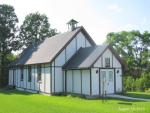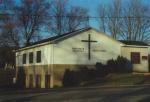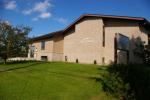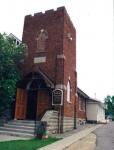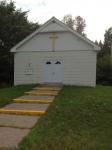Bar River United Church

Location
Sunday service: 10:00 am, September through June.
(Closed during August: joining with Echo Bay UC for services at 11:15 am.)
One of the earliest settlers in the Bar River area was John Evoy. Although a lay preacher of the Methodist church he labored for many years as Sunday School Superintendent of the Presbyterian Church. By 1907 the Methodists of the Bar River community jet at the home of Wm. Evoy, son of John, for worship. It was called "Evoy’s Appointment" and had its first minister in the person of Rev. A.P. Standley. In 1909 a church was built on the homestead property of John Evoy.
In 1917 a few Presbyterians united with the Methodists to form a union congregation. They met in the Methodist church building and were served by Methodist ministers. It was destroyed by fire in 1935 and during this same year, under the leadership of Rev. Gosse , the present building was erected.
This little county church had been a simple one-room sanctuary until 1965 when its 30th anniversary was also the time for a dedication service for the new Sunday School room which had been added to the back of the church. At the same time the ladies of the congregation had financed a remodeling job to the front of the building. The Sunday School , through a project of their own, raised money to purchase padded chairs for the church. At that time, fifty children were enrolled in the church school.
And the U.C.W ./ The minute books of yesteryear shed some interesting sidelights. The oldest one dates back to 1925 and belonged to the Women’s Missionary Society. In this book the only mention of Union is where, on the cover, the word "Methodist" is stroked out and "United" is written over it. Temperance played a large part in their programming.
In the Ladies’ Aid minute book (1929-34) is a bill for "rope for the bell – 35 cents; another showed six dozen plates were bought for less than $15.00. The thirties ushered in the depression and raising money was very difficult. In those days plays were more popular than bazaars and suppers. A completed quilt yielded $4.50 - $6.00, five pounds of butter cost $1.65. A neighborhood youngster earned $3.90 yearly for caretaking the church. A local boy was paid $5.50 a year for lighting fires in the church stove. By 1944 church suppers had fixed prices. A fowl meal brought 75 cents and these would be chicken rather than turkey.
Donations to our Memorial Fund have been instrumental in making it possible to carry on with two projects within our small rural church. In the fall of 1984 a new and larger vestibule was erected at the entrance of the sanctuary. As volunteer labour built this addition, it seems the latter months of the year are more suitable for obtaining this type of help. In December 1986 a new organ was placed in the sanctuary.







